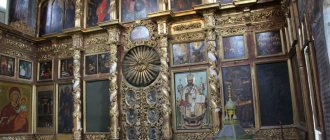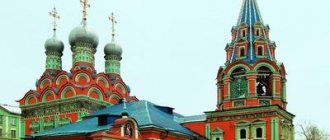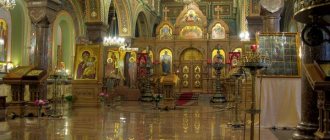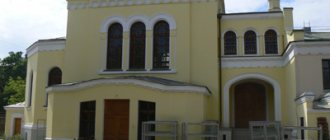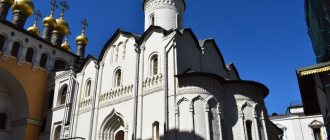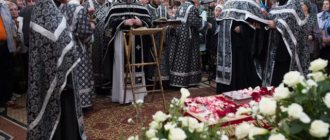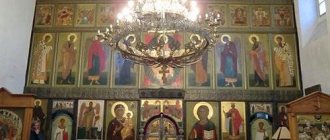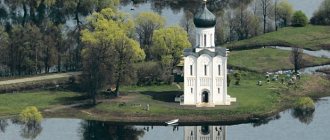Mir
Russia Yaroslavl region Uglich Church of Tsarevich Dimitri “on the field” (Uglich) Map is loading...
{"format":"leaflet","minzoom":false,"maxzoom":false,"limit":50,"offset":0,"link":"all","sort":[""], "order":[],"headers":"show","mainlabel":"","intro":"","outro":"","searchlabel":"\u2026 \u0441\u043b\u0435\ u0434\u0443\u044e\u0449\u0438\u0435 \u0440\u0435\u0437\u0443\u043b\u044c\u0442\u0430\u0442\u044b","default":"","import-annotation":false,"width ":"auto","height":"350px","centre":{"text":"","title":"""link":"""lat":57.5288139000000029454895411618053913116455078125,"lon": 38.31813609999999670208126190118491649627685546875,"icon":""},"title":"","label":"","icon":"","lines":[],"polygons":[],"circles":[ ],"rectangles":[],"copycoords":false,"static":false,"zoom":8,"defzoom":14,"layers":["OpenStreetMap"],"image layers":[] ,"overlays":[],"resizable":false,"fullscreen":true,"scrollwheelzoom":true,"cluster":false,"clustermaxzoom":9,"clusterzoomonclick":true,"clustermaxradius":80, "clusterspiderfy":true,"geojson":"","clicktarget":"","showtitle":true,"hidenamespace":false,"template":"","userparam":"","activeicon": "","pagelabel":false,"ajaxcoordproperty":"","ajaxquery":"","locations":[{"text":"\u003Cb\u003E\u003Ca href=\"/palomnik/%D0% A6%D0%B5%D1%80%D0%BA%D0%BE%D0%B2%D1%8C_%D1%86%D0%B0%D1%80%D0%B5%D0%B2%D0%B8% D1%87%D0%B0_%D0%94%D0%B8%D0%BC%D0%B8%D1%82%D1%80%D0%B8%D1%8F_%22%D0%BD%D0%B0_% D0%BA%D1%80%D0%BE%D0%B2%D0%B8%22_(%D0%A3%D0%B3%D0%BB%D0%B8%D1%87)\» title=\»\ u0426\u0435\u0440\u043a\u043e\u0432\u044c \u0446\u0430\u0440\u0435\u0432\u0438\u0447\u0430 \u0414\u0438\u043c\u0438\u0442\u0 440\u0438\u044f\u0026quot;\u043d \u0430 \u043a\u0440\u043e\u0432\u0438\u0026quot; (\u0423\u0433\u043b\u0438\u0447)\»\u003E\u0426\u0435\u0440\u043a\u043e\u0432\u044c \u0446\u0430\u0440\u0435\u0432\u0438\u044 7\u0430\u0414\u0438 \u043c\u0438\u0442\u0440\u0438\u044f \"\u043d\u0430 \u043a\u0440\u043e\u0432\u0438\" (\u0423\u0433\u043b\u0438\u0447)\u003C/ a\u003E\u003C /b\u003E\u003Chr /\u003E\u003Ca href=\"/palomnik/%D0%A1%D0%B2%D0%BE%D0%B9%D1%81%D1%82%D0%B2%D0%BE :%D0%90%D0%BD%D0%BD%D0%BE%D1%82%D0%B0%D1%86%D0%B8%D1%8F\» title=\»\u0421\u0432\u043e\ u0439\u0441\u0442\u0432\u043e:\u0410\u043d\u043d\u043e\u0442\u0430\u0446\u0438\u044f\»\u003E\u0410\u043d\u043d\u043e\u0442\u 0430\u0446\u0438\u044f \u003C/a\u003E: "'\u0426\u0435\u0440\u043a\u043e\u0432\u044c \u0414\u0438\u043c\u0438\u0442\u0440\u0438\u044f \"\u043d\u043 0\u043a\u0440\ u043e\u0432\u0438\""' \u2014 \u0432\u043e\u0437\u0432\u0435\u0434\u003Cspan class=\"smw-highlighter\" data-type=\"2\" data-state=\"persistent \" data-title=\"\u0418\u043d\u0444\u043e\u0440\u043c\u0430\u0446\u0438\u044f\" title=\"\u0026#039;\u0026#039;\u0026#039;\ u0426\u0435\u0440\u043a\u043e\u0432\u044c \u0414\u0438\u043c\u0438\u0442\u0440\u0438\u044f \u0026quot;\u043d\u0430 \u043a\u0440 \u043e\u0432\u0438\u0026quot;\ u0026#039;\u0026#039;\u0026#039; 2014 \u0441\u043d\u043e\u043c \u043a \u0440\u0443\u0442\u043e\u043c \u0431\u0435\u0440\u0435\u0433\u0443 \u0412\u043e\u043b\u0433\u0438 \u0445\u0440\u0430\u043c \u0423\u0433\u043b\u0438\u0447 \u0441\u043a\u043e\u0433\u043e \u043a\u0440\u0435\u043c\u043b\u044f,\u043a\u043e\u0442\u043e\u0440\u044b\u0439 \u043e\u043 1\u043e\u0437\u043d\u0430\ u0447\u0430\u0435\u0442 \u043c\u0435\u0441\u0442\u043e \u0443\u0431\u0438\u0435\u043d\u0438\u044f \u0446\u0430\u0440\u0435\u 0432\u0438\u0447\u0430\u0414\ u0438\u043c\u0438\u0442\u0440\u0438\u044f \u0423\u0433\u043b\u0438\u0447\u0441\u043a\u043e\u0433\u043e. Since 2001 \u043a\u0430\u043d\u0434\u0438 \u0434\u0430\u0442\u043e\u043c \u043d\u0430 \u0432\u043a\u043b\u044e\u0447\u0435\u043d\u0438\u0435 \u0432 \u0441\u043f\u043 8\u0441\u043e\u043a\u0412\u0441 \u0435\u043c\u0438\u0440\u043d\u043e\u0433\u043e \u043d\u0430\u0441\u043b\u0435\u0434\u0438\u044f \u042e\u041d\u0415\u0421\ u041a\u041e.\»\u003E\ u003Cspan class=\»smwtext\»\u003E \u2026 \u003C/span\u003E\u003Cspan class=\»smwttcontent\»\u003E»'\u0426\u0435\u0440\u043a\u043e\u0432\u044c \u0414\ u0438\ u043c\u0438\u0442\u0440\u0438\u044f \»\u043d\u0430 \u043a\u0440\u043e\u0432\u0438\»»' \u2014 \u0432\u043e\u0437\u0432\u0435\ u0434\u0435\u043d\ u043d\u044b\u0439 \u043d\u0430 \u0436\u0438\u0432\u043e\u043f\u0438\u0441\u043d\u043e\u043c \u043a\u0440\u0443\u0442\u043e\u 043c\u0431\u0435\u0440\u0435\ u0433\u0443 \u0412\u043e\u043b\u0433\u0438 \u0445\u0440\u0430\u043c \u0423\u0433\u043b\u0438\u0447\u0441\u043a\u043e\u0433\u 043e\u043a\u0440\u0435\u043c\ u043b\u044f, \u043a\u043e\u0442\u043e\u0440\u044b\u0439 \u043e\u0431\u043e\u0437\u043d\u0430\u0447\u0430\u0435\u0442 \u043c\ u0435\u0441\u0442\u043e\u0443 \u0431\u0438\u0435\u043d\u0438\u044f \u0446\u0430\u0440\u0435\u0432\u0438\u0447\u0430 \u0414\u0438\u043c\u0438\u0442\u0440\ u0438\u044f\u0423\u0433\u043b \u0438\u0447\u0441\u043a\u043e\u0433\u043e. Since 2001 \u043a\u0430\u043d\u0434\u0438 \u0434\u0430\u0442\u043e\u043c \u043d\u0430 \u0432\u043a\u043b\u044e\u0447\u0435\u043d\u0438\u0435 \u0432 \u0441\u043f\u043 8\u0441\u043e\u043a\u0412\u0441 \u0435\u043c\u0438\u0440\u043d\u043e\u0433\u043e \u043d\u0430\u0441\u043b\u0435\u0434\u0438\u044f \u042e\u041d\u0415\u0421\ u041a\u041e.\u003C/span\ u003E\u003C/span\u003E\u0447\u0435\u043d\u0438\u0435 \u0432 \u0441\u043f\u0438\u0441\u043e\u043a \u0412\u0441\u0435\u043c\u043 8\u0440\u043d\u043e\u0433\ u043e \u043d\u0430\u0441\u043b\u0435\u0434\u0438\u044f \u042e\u041d\u0415\u0421\u041a\u041e.","title":"\u0426\u0435\u0440\u043a\u 043e\u0432\ u044c \u0446\u0430\u0440\u0435\u0432\u0438\u0447\u0430 \u0414\u0438\u043c\u0438\u0442\u0440\u0438\u044f \u043d\u0430 \u043 a\u0440\u043e\u0432\u0438\ "(\u0423\u0433\u043b\u0438\u0447)","link":"""lat":57.5288139000000029454895411618053913116455078125,"lon":38.3181360999999967020812 6190118491649627685546875,"icon":""}],"imageLayers":[]}
57.528892; 38.318384
Russia, Yaroslavl region, Uglich, Kremlin street, 2
Uglich, Yaroslavl region 152615
Russia
Telephone:
8(48532) 2 22 67.
Church of Demetrius "on the field"
- an Orthodox church in honor of Tsarevich Demetrius of Uglich, built between 1798 and 1814.
History[edit]
There is a beautiful legend about the construction of the church. In the summer of 1606, the relics of Tsarevich Dmitry were transferred from the city of Uglich to Moscow, and the procession began to move towards the Moscow road. While the relics were passing through the St. John the Theologian Monastery, the stretcher suddenly stopped and “froze” in place, never moving again. Due to this circumstance, many decided that it was worth going only along the Rostov road, along which the procession continued. Before leaving the city, the procession stopped again so that numerous believing townspeople could finally say goodbye to the relics of the prince. Throughout the day, the clergy held divine services in the open air.
During the Divine Liturgy, an amazing event was noticed, which became the basis for the construction of the temple - a small stream of blood poured from the coffin of Tsarevich Dmitry onto the earth's surface - this is what served as the beginning of the foundation of the church at this place.
The shrine was carefully collected by representatives of the clergy and enclosed together with particles of earth in a shrine made of silver. A month later, the procession arrived in Moscow, and the prince’s body rested forever in the building of the Archangel Cathedral of the Kremlin. Thus, the residents of Uglich were able to find a great wonderworker and intercessor from God.
Some time later, on the spot where the townspeople said goodbye to the relics of Tsarevich Dmitry for the last time, a small chapel was erected. At the end of 1693, the old warm temple operating at the Transfiguration Cathedral was moved to the location of the Kremlin chapel, because then a new temple was built in the Kremlin. The previous church stood on this site for 40 years - until 1729 - then a stone temple was erected here, consecrated in honor of Saints Julita and Kirik and Tsarevich Demetrius. After 50 years had passed since its construction, a temple that exists to this day was built at some distance from it, named in honor of Demetrius “on the field.”
In the interior, paintings dating back to 1836 have been preserved to this day; they are especially close in the manner of execution to the frescoes located at the Transfiguration Cathedral, which operates under the Uglich Kremlin. According to what has been said, many scientists believe that the two temples were painted by one team. In both churches there are illusory forms represented by a coffered vault, columns, as well as plots in which the laconicism of the cemetery church is manifested. Today you can see a carved iconostasis designed in the form of a triumphal arch.
It can be considered a coincidence, but the church of Tsarevich Dimitri “on the field” was never closed - apparently the city truly found its patron. During the years of Soviet power, it was the only temple in Uglich that was not closed and remained operational.
Architecture, decoration
The small one-story, five-domed temple is equipped with a refectory and a small bell tower. Classical forms and techniques are widely used in the decoration: examples are Tuscan columns, pediments located in front of the quadrangle, pilasters, cornices and the design of the bell tower. Inside, paintings from 1836 and a carved iconostasis designed in the shape of a triumphal arch have been preserved. The temple is one of the important historical monuments of its time.
| Uglich temple of Tsarevich Dimitri on the field |
Shrines[edit]
2016 marks the 205th anniversary of one of the revered shrines - the icon of the holy martyr John the Warrior. The image was donated to the temple by the Uglich merchant Mikhail Alexandrovich Khorkhorin.
It is also the 205th anniversary of the temple icon of Tsarevich Demetrius, painted in 1811 by Uglich craftsmen for this church. It is known that she participated in all religious processions throughout the city of Uglich, held on the Feast of the Intercession of the Mother of God.
At the right choir there is a shrine with a particle of the relics of Tsarevich Dimitri and a shroud.
Here is the ark with the relics of the Holy Prince Roman of Uglich. He was the third Uglich prince and on the princely throne he was elevated by virtues and piety to the rank of locally revered saints.
The relics were found in 1495. In 1595 there was his general glorification. In 1611, during the Polish-Lithuanian intervention, the relics suffered from a fire and, along a luminous pillar above them, were recovered from the ashes a second time. Since 1930 they were in the Uglich Museum, and in 1989 they were transferred to the church.
At the left choir there is a reliquary with the relics of the infant martyr John (Chepolosov), killed on May 25 (June 8), 1663. He showed a high confession of love for God and parents, refusing to study magic, for which he suffered cruel torture from his fanatic teacher. Soon the relics were miraculously recovered and glorified by the church commission. Already his parents, who were building a temple on the grave of their son, prayed to him.
In the small iconostasis of the chapel of Kirik and Iulitta there is a miraculous image of the Intercession of the Most Holy Theotokos, brought from the Intercession Monastery, which was devastated in 1930.
According to legend, the icon sailed on the water and stopped in front of the monastery. Monk Bogolep, a baker, came to the shore for water and when he saw the image he announced it to the brethren. The icon was taken out of the water and placed in the temple. She immediately showed herself with many miracles and healings. A cathedral was built in honor of the icon and the monastery began to be called Pokrovsky. Processions of the cross were held with this icon every year.
Here are also the revered icon of the Mother of God “Unexpected Joy”, the Myrrh-Streaming Icon “Tikhvin”, the revealed icon of the Korsun Mother of God from the source of the village of Stana and the Athos image of St. Nicholas.
At the exit is a temple icon of the Uglich Saints, painted in 1951 for the 150th anniversary of the temple with the blessing of the rector of the temple, Hieromonk Nikodim (Rotov), later Metropolitan and prominent hierarch of the Russian Orthodox Church.
The local clergy rests in the temple graveyard, at whose graves pilgrims pray.
Helpful information
The old temple is loved by pilgrims and tourists who travel along the routes of the “Golden Ring” of Russia. The church is active, its doors are open to visitors any day from morning to evening. There is a special atmosphere inside and it is easy to feel the spirit of history.
The shrines of the temple include a shrine with the relics of Prince Roman of Uglich and icons of the early 19th century, which depict Tsarevich Dimitri and the martyr John the Warrior.
Reliquary with the relics of Prince Roman of Uglich
Monument to Tsarevich Dimitri
The monument to Tsarevich Dimitri is located near the chambers of the Uglich Kremlin. The author is Abbot Rafail, the world famous avant-garde artist Sergei Simakov. In the 1980s, he and his wife settled near Uglich. Soon Sergei became a priest, and after the death of his wife he took monastic vows. The priest took the image of the prince from Mikhail Nesterov’s painting “Dmitry, the murdered prince.”
The famous alarm bell of Uglich
There is a bell inside the church of Tsarevich Dimitri. His story is unusual. It was he who announced the death of the young prince to the inhabitants of the city. After its ringing, numerous disturbances followed. Angry residents gathered on the territory of the Kremlin and dealt with the alleged murderers. For committing lynching, several residents of the city were exiled to Siberia, and Dmitry’s mother was tonsured a nun. Even the bell was punished.
He was thrown from the bell tower of the Transfiguration Cathedral, his tongue was torn out, one ear was cut off, he was beaten with whips and sent into exile in the Siberian city of Tobolsk. After 300 years, the bell returned to the city of Uglich. But not to its former place in the bell tower. It was installed inside the Church of Tsarevich Demetrius, where everyone can see it. This bell formed the basis of the plot of many works.
Church of Tsarevich Dimitri “on the field”
information » Temples and monasteries » Church of Tsarevich Demetrius “on the field”
Share
print version
At the entrance from Rostov Velikiy to Uglich, on Rostovskaya Street, guests of the city are greeted by an elegant small church. This is the church of Tsarevich Dimitri “on the field”. The existing stone church was built in 1798-1814. But the construction of the current temple was preceded by a long history, about which there is a legend...
On June 3, 1606, when the relics of Tsarevich Dimitri were transferred from Uglich to Moscow, the procession first set off along the Moscow road. But at the exit from the city at the St. John the Theologian Monastery, the carriers with the relics suddenly stopped and they could not be moved from their place. Because of this, they decided that we needed to go along the Rostov road. The procession continued along it. At the exit from the city, the procession stopped again so that the townspeople could say goodbye to the prince. The clergy continuously conducted divine services for 24 hours in the open air.
During the Divine Liturgy, an event occurred that marked the beginning of the foundation of the temple at this place - from the coffin where the relics of Demetrius were located, a trickle of blood spilled onto the ground. The shrine was carefully collected by the clergy and placed in a silver shrine along with the earth. On July 3, the funeral procession solemnly arrived in Moscow. The body of Tsarevich Dimitri rested in the Archangel Cathedral of the Kremlin. The people of Uglich found from the Lord their intercessor and miracle worker.
Soon, a chapel was built at the holy place where the townspeople said goodbye to Tsarevich Demetrius. In 1693, the old warm church at the Spaso-Preobrazhensky Cathedral was moved to the place of the chapel from the Kremlin, as a new one was being built in the Kremlin. The “Kremlin” church stood for more than forty years, until 1729, when a stone church of Tsarevich Demetrius and Saints Kirik and Julita was erected in its place. And after another half a century, an existing temple was erected a little to the side of the previous one, which was popularly called the Church of Demetrius “on the field” (as it is called, in contrast to the Kremlin temple “on the blood”).
The church “on the field” is a typical monument of its time. It is one-story, five-domed with a refectory and a bell tower. With a traditional composition, its decoration is dominated by forms of classicism. These are the four Tuscan columns, pediments in front of the quadrangle, pilasters, cornices, and the design of the bell tower. The church cannot be called an interesting architectural monument, but it is beautiful and remarkable in its own way, and most importantly, it is an important historical monument and shrine of these places.
Inside, paintings from 1836 have been preserved, similar in style to the frescoes of the Transfiguration Cathedral in the Uglich Kremlin, which is why researchers believe that both churches were painted by the same artel. Here, too, you will encounter illusory forms - columns, a coffered vault, combined with the marks of saints and subjects, but, of course, the modesty of a small cemetery church is visible in everything. The carved iconostasis in the shape of a triumphal arch has also been preserved.
It’s probably no coincidence that the church dedicated to the city’s heavenly patron never closed and remained the only functioning church during the Soviet years. Surviving shrines and icons from all over Uglich were brought here. In 1989, the relics of the holy noble Uglich prince Roman in a silver shrine were donated to the temple. He was the third Uglich prince and on the princely throne he was elevated by virtues and piety to the rank of locally revered saints. The relics were found in 1495. In 1595 there was his general glorification. In 1611, during the Polish-Lithuanian intervention, the relics suffered from a fire and, along a luminous pillar above them, were recovered from the ashes a second time. Since 1930 they were in the Uglich Museum.
On September 9, 2010, the city of Uglich and the Temple of Tsarevich Dmitry “on the field” were visited by His Holiness Patriarch Kirill of Moscow and All Rus'.
Address: st. Rostovskaya, 60.
Phone: 8 (48532) 2-22-67.
Rector: Archpriest Vladimir
Write a comment
